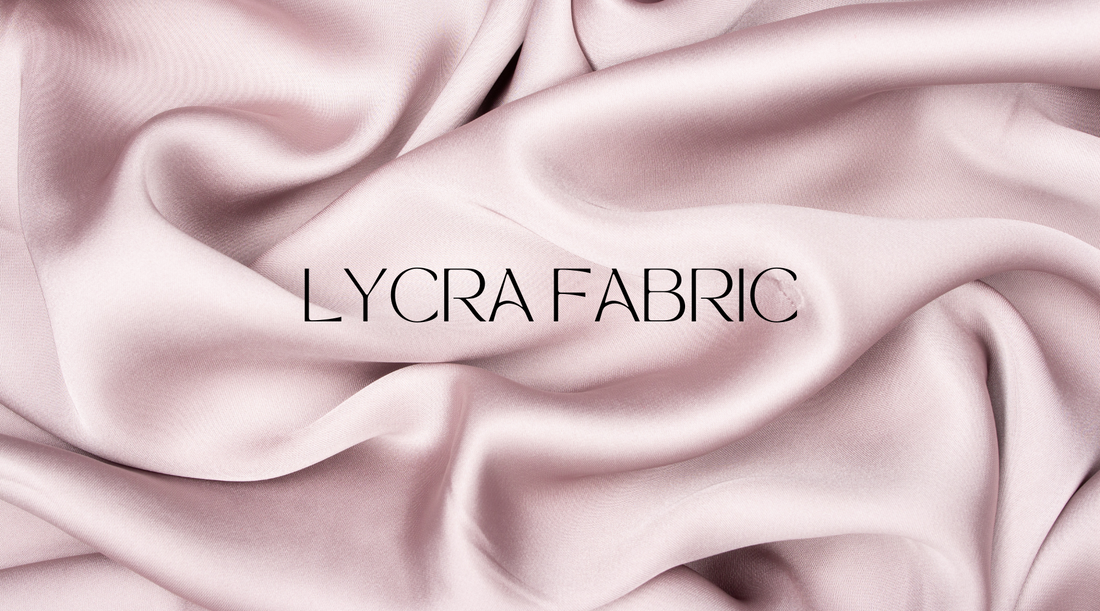Lycra fabric, also known as spandex or elastane, is a synthetic fiber known for its exceptional elasticity. It was developed in the early 1960s by chemist Joseph Shivers at DuPont's Benger Laboratory in Virginia, United States. Lycra is composed of a long-chain polymer called polyurethane, which is known for its stretchability and strength. When woven or knitted into fabric, Lycra provides unparalleled stretch and recovery properties, making it an essential material in the production of various garments and textiles.
How Is Lycra Fabric Made?
The production process of Lycra fabric involves several stages:
Polyurethane Polymerization: The process begins with the polymerization of polyurethane, which involves the reaction of diisocyanates with diols. This results in the formation of long-chain polymers with alternating rigid and flexible segments.
Spinning: Once the polyurethane polymer is synthesized, it is spun into fibers through a process called dry spinning or melt spinning. In dry spinning, the polymer is dissolved in a solvent, extruded through spinnerets, and then solidified into fibers through evaporation of the solvent. In melt spinning, the polymer is melted and extruded through spinnerets, then cooled to form solid fibers.
Drawing: The spun fibers are then stretched or drawn to align the molecular chains, which enhances their strength and elasticity. This drawing process is crucial for achieving the desired stretch properties of the Lycra fabric.
Finishing: After drawing, the fibers may undergo various finishing processes such as heat setting, dyeing, and lubrication to improve their appearance, color, and handling characteristics.
Weaving or Knitting: Finally, the Lycra fibers are woven or knitted into fabric along with other fibers such as cotton, polyester, or nylon to create stretchable textiles suitable for various applications.
How Is Lycra Fabric Used?
Lycra fabric is widely used in the textile and apparel industry for its unique stretch and recovery properties. Some common applications of Lycra fabric include:
Athletic Wear: Lycra is a popular choice for activewear, sportswear, and athletic compression garments due to its ability to provide freedom of movement, support muscles, and enhance performance.
Intimate Apparel: Lycra is frequently used in lingerie, underwear, and swimwear to provide a comfortable and form-fitting fit.
Fashion Apparel: Many fashion designers incorporate Lycra fabric into their collections to create form-fitting dresses, skirts, tops, and trousers that accentuate the body's contours.
Medical Textiles: Lycra fabric is also used in medical textiles such as compression stockings, bandages, and surgical garments to provide support and compression for various medical conditions.
Where Is Lycra Fabric Produced?
Lycra fabric is produced by several manufacturers around the world. Some of the leading producers of Lycra include:
DuPont: DuPont, the company where Lycra was originally developed, continues to be a major producer of Lycra fabric. The company has manufacturing facilities in various countries including the United States, China, and Singapore.
Invista: Invista, a subsidiary of Koch Industries, is another prominent producer of Lycra fabric. The company operates manufacturing plants in the United States, Brazil, China, and other locations.
Hyosung Corporation: Based in South Korea, Hyosung Corporation is a leading producer of spandex fibers under the brand name Creora. The company has manufacturing facilities in South Korea, China, Vietnam, and Turkey.
Additionally, there are numerous other textile manufacturers and suppliers worldwide that produce Lycra fabric under license from DuPont or Invista.
How Much Does Lycra Fabric Cost?
The cost of Lycra fabric can vary depending on various factors such as the quality of the fibers, the manufacturing process, and the supplier. Generally, Lycra fabric tends to be more expensive than traditional fabrics like cotton or polyester due to its specialized properties and production methods. However, the price of Lycra fabric has become more competitive over the years as production technologies have advanced and competition among manufacturers has increased.
What Different Types of Lycra Fabric Are There?
There are several different types of Lycra fabric available, each with unique properties and characteristics tailored to specific applications. Some common types of Lycra fabric include:
Standard Lycra: Standard Lycra fabric offers excellent stretch and recovery properties, making it suitable for a wide range of applications including apparel, sportswear, and swimwear.
High-Performance Lycra: High-performance Lycra fabric is engineered to provide enhanced durability, shape retention, and moisture-wicking properties, making it ideal for high-intensity athletic activities and outdoor wear.
Lightweight Lycra: Lightweight Lycra fabric is designed to be lightweight and breathable, making it suitable for activewear, yoga pants, and other garments where comfort and flexibility are essential.
Compression Lycra: Compression Lycra fabric applies targeted pressure to specific areas of the body, promoting circulation, muscle support, and faster recovery times. It is commonly used in compression garments for athletes, travelers, and individuals with certain medical conditions.
Printed Lycra: Printed Lycra fabric features vibrant colors and patterns printed directly onto the fabric surface, making it ideal for fashion apparel, swimwear, and costumes.
These are just a few examples of the many types of Lycra fabric available on the market, each offering unique benefits depending on the intended use and preferences of the consumer.
How Does Lycra Fabric Impact the Environment?
The production and disposal of Lycra fabric can have environmental implications, primarily due to the use of petrochemical-based materials and energy-intensive manufacturing processes. Some of the key environmental considerations associated with Lycra fabric include:
Resource Depletion: Lycra fabric is made from petrochemical-based materials, which are non-renewable resources. The extraction and processing of these materials can contribute to resource depletion and environmental degradation.
Energy Consumption: The production of Lycra fabric requires significant amounts of energy, particularly during the polymerization and spinning processes. This energy consumption contributes to greenhouse gas emissions and climate change.
Chemical Pollution: The manufacturing process of Lycra fabric involves the use of various chemicals, including solvents, dyes, and finishing agents. Improper disposal of these chemicals can lead to water and soil pollution, harming ecosystems and human health.
Waste Generation: The textile industry generates large amounts of waste, including offcuts, scraps, and unused materials. Proper waste management practices, such as recycling and waste-to-energy technologies, can help mitigate the environmental impact of Lycra fabric production.
Despite these environmental challenges, efforts are underway to develop more sustainable alternatives to traditional Lycra fabric, such as bio-based elastane derived from renewable sources like plants or algae. Additionally, advancements in recycling technologies and circular economy initiatives aim to reduce the environmental footprint of synthetic fibers like Lycra.
Lycra Fabric Certifications Available
Several certifications and standards are available to help consumers identify and choose more sustainable and ethically produced Lycra fabric. Some of the key certifications and standards include:
OEKO-TEX Standard 100: This certification ensures that the Lycra fabric has been tested for harmful substances and meets stringent human-ecological requirements.
Global Recycled Standard (GRS): The GRS certifies products made from recycled materials, including Lycra fabric. It verifies the use of recycled content and responsible manufacturing practices.
Bluesign System: The Bluesign System assesses the environmental impact of the entire textile supply chain, from raw materials to finished products. Lycra fabric certified by Bluesign meets strict criteria for resource efficiency, consumer safety, and environmental protection.
Cradle to Cradle Certified: Cradle to Cradle certification evaluates products based on their environmental and social performance across five sustainability categories: material health, material reutilization, renewable energy and carbon management, water stewardship, and social fairness.
By choosing Lycra fabric certified by these or other reputable standards, consumers can support more sustainable and environmentally responsible production practices in the textile industry.
In conclusion, Lycra fabric is a versatile and widely used material known for its exceptional stretch and recovery properties. From athletic wear to fashion apparel, Lycra fabric plays a crucial role in various industries and applications. However, its production and disposal can have environmental consequences, highlighting the importance of sustainable practices and certifications in the textile industry. As technologies and awareness continue to evolve, the future of Lycra fabric holds promise for more sustainable and eco-friendly alternatives.
















